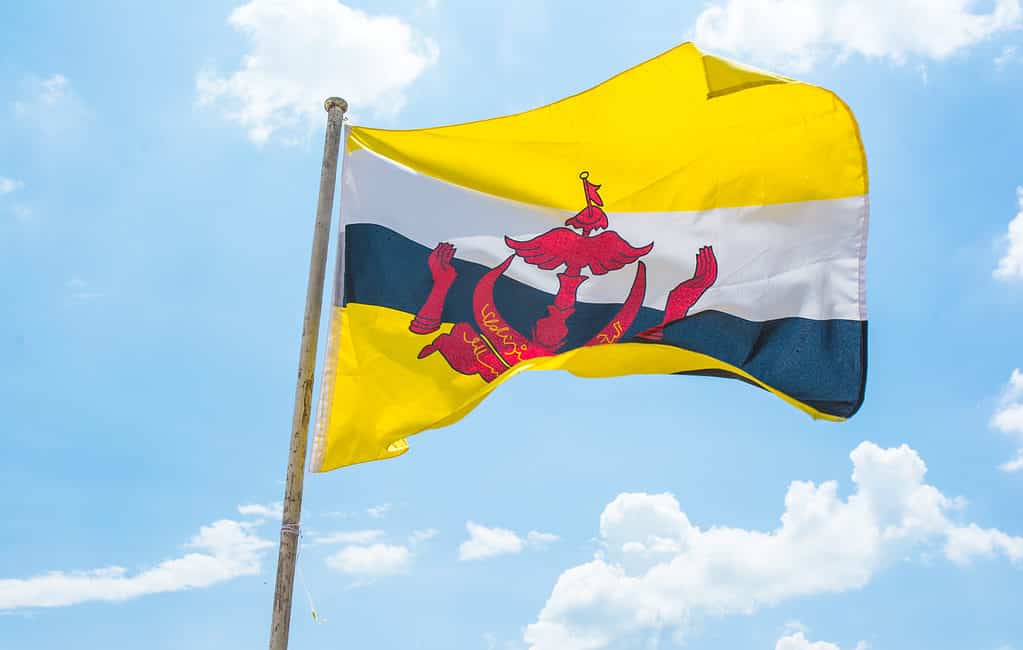Flags can be any color and design, and some even seem as though they are a random assortment of hues and symbols. However, this is never the case. Flags represent many different cultural aspects, whether it be history, liberty, control, or protection. In fact, quite often flags symbolize the past, present, and future of the nation they represent. But what does the flag of Brunei Darussalam represent? Let’s find out!
Characteristics of Brunei Darussalam
Brunei Darussalam is a small country located on the island of Borneo in southeast Asia. It consists of two unconnected landmasses, which are divided by the Sarawak district of Limbang, Malaysia. The western region is the larger of the two segments, and home to the capital city of Bandar Seri Begawan. This city is home to around 100,000 people — almost a quarter of the country’s entire population of 440,000.
Most of the country lies within the Borneo lowland rainforest region. There are mountain rainforests located inland. As such, Brunei has a tropical rainforest climate. The temperature is warm throughout the year and can fluctuate between the mid-70s and 90°F every day. Rainfall is usually heavier between October and January and inland regions can receive as much as 150 inches of rain annually.
Brunei Darussalam is also home to many different animals. Mammals are particularly abundant, and these include the sun bear, slow loris, and the rare proboscis monkey and the Sunda clouded leopard. However, mammals don’t receive all the attention, as the national animal is the white-bellied sea eagle.
History of Brunei Darussalam
For a large part of its history, Brunei was the Bruneian Sultanate (1368-1888) and ruled by Sultans. Although Brunei endured several skirmishes with Spain in the 1500s, the conflict died down. However, eventually the Bruneian Sultanate disbanded, and disputes began over who was the rightful Sultan. In 1888, the then Sultan appealed to the UK for help after losing land to the Raj of Sarawak, along with a dynasty known as the White Rajahs. As a result, a Treaty of Protection was signed which effectively gave Britain control over Brunei’s external affairs and prevented it from conceding any land without their consent. This meant that Brunei became a British protected state — or British protectorate.
However, in 1890 the Raj of Sarawak annexed another region of Brunei without being stopped by the British. This was the land that now makes up the region of Sarawak that divides the two halves of Brunei.
With the exception of a period of occupation by Japan during the Second World War, Brunei largely remained under the protection of Britain from 1888 until it gained full independence in 1984.
Previous Flags of Brunei Darussalam
The first main flag of Brunei was the flag of the Bruneian Sultanate. This flag was a simple yellow field with no other colors or designs adorning it. This flag represented Brunei during the entire period of the Bruneian Sultanate, from 1368 to 1888. However, although Brunei became a British protectorate in 1888, this flag continued to be used until 1906.
In 1906 the flag representing the British Protectorate of Brunei was changed to a yellow background with two diagonal stripes across it. The stripes were black and white, with the white stripe above and the black stripe underneath it. This flag remained in use until 1959 when Brunei became an independent country.
History of the Flag of Brunei Darussalam

The flag of Brunei consists of a yellow background with black and white diagonal stripes. The national emblem of Brunei is in the center.
©Jill WT/Shutterstock.com
The current flag of Brunei builds on the country’s previous flags. The flag of Brunei Darussalam was adopted on September 29, 1959. It again consists of a yellow background with the black and white diagonal stripes. However, in the center of the flag is the national emblem of Brunei.
The crest was added to the previous flag when a constitution was signed declaring Brunei as a self-governing state, although its security, defense, and foreign affairs were still the responsibility of the UK. Brunei then gained full independence from the UK on January 1, 1984, and the flag remained the same.
Symbolism and Meaning
Every detail of the flag of Brunei Darussalam stands for a specific aspect of the nation’s history or culture. Although yellow is not a color that is often used on flags, it is most popular on those in southeast Asia, where it is traditionally the color of royalty. The diagonal stripes represent the chief ministers of Brunei. The First Minister is represented by the white stripe, which is slightly thicker than the black stripe, which represents the Second Minister.
The national emblem is red and was adopted in 1940. It has five main parts — the flag, wings, hands, crescent, and the royal parasol (ceremonial umbrella). Below the crescent is a banner, with both having yellow Arabic lettering on them. Brunei’s national motto, which when translated means, “Always in service with God’s guidance”, is inscribed on the crescent. The banner beneath reads Brunei Darussalam, which translated means, “Brunei, the Abode of Peace”.
The parasol and the small swallowtail flag above it have formed part of the royal insignia since the creation of the national emblem. They were also part of the regalia of the original sultanate’s monarchy.
The wings below the parasol represent peace, tranquility, justice, and prosperity. The crescent is the symbol of Islam, which is also the official religion of Brunei. To either side of the crescent is a pair of upturned hands. These represent the government’s duty to protect the people of Brunei and to promote their welfare. Therefore, the emblem is a fitting addition to the flag upon the country achieving its independence.
Up Next
- The Different Flags That Use Crescent Shapes
- The Don’t Tread on Me Flag and Phrase: History, Meaning & Symbolism
- 6 Countries with Blue and Yellow Flags
The photo featured at the top of this post is © Anastassiia Guseva/Shutterstock.com
Sources
- britannica, Available here: https://www.britannica.com/topic/flag-of-Brunei
- wikipedia, Available here: https://en.wikipedia.org/wiki/Emblem_of_Brunei
Thank you for reading! Have some feedback for us? Contact the AZ Animals editorial team.






